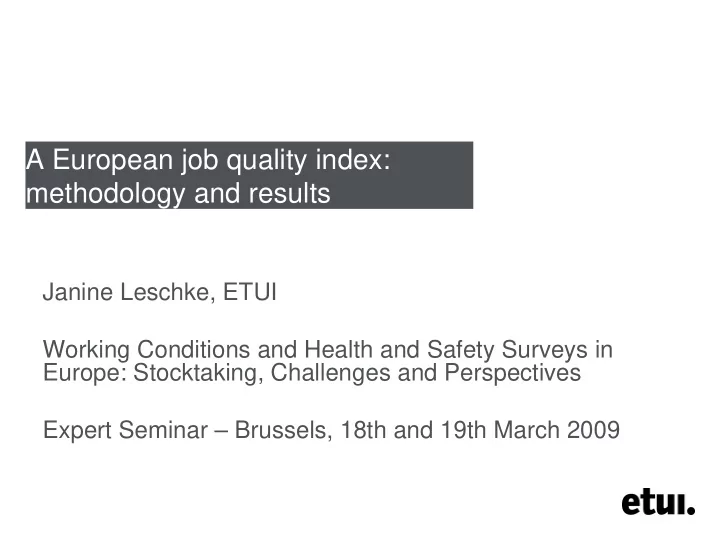

A European job quality index: methodology and results Janine Leschke, ETUI Working Conditions and Health and Safety Surveys in Europe: Stocktaking, Challenges and Perspectives Expert Seminar – Brussels, 18th and 19th March 2009
Background information � Lisbon strategy: more AND BETTER jobs � Clear targets in EES for more jobs � Targets on better jobs much less clear (Laeken indicators) � Contrasting hypotheses: ‚bad jobs‘ and rising precarity vs. sectoral shifts that reduce incidence of poor working conditions � Response by policymakers and academics Eurofound EWCS and other work (e.g. ESWT) � ILO Decent work agenda � Numerous national and some comparative studies � 2
Data sources, problems and short-comings What‘s needed? � Job quality index that allows comparisons between EU 27 countries, over time and between men and women Scope? � Focus on the quality of ‘jobs themselves’ (not welfare states or quantitative labour market indicators) Which data is used? � European labour force survey (LFS); European Working Conditions Survey (EWCS); AMECO data base; Survey of Income and Living Conditions (EU-SILC); ICTWSS database Shortcomings: � For some fields no (e.g. health and safety for EU-27) or limited information (collective interest representation and skills and career development) that meets the index requirements � EWCS data only available every 5 years (e.g. field of ‘working conditions and job security’ will not change regularly) � Data constraints mean that backward-looking time comparison is only possible for EU-15 and there are slight definitional differences between 2006 indicator for EU-15 and EU-27 3
Components of the job quality index (JQI) The JQI is an unweighted average of the following six sub-indices that each consist of a number of weighted indicators � Wages � Non-standard forms of employment � Working time and work-life balance � Working conditions and job security � Skills and career development � Collective interest representation Example: indicators of ‘working conditions and job security’ sub- index � Work intensity (EWCS) (25%) � Work autonomy (EWCS) (25%) � Physical work factors (EWCS) (25%) � “I might loose my job in the next six month” (EWCS) (25%) 4
Aggregation method � Data series have to be normalised to be comparable and suitable for aggregation � Max and min values of each indicator are identified (some indicators are inverted) � Each country is scored between 0 and 1: (country value - min)/(max - min) � Using total (m+f) values for a base year allows analysis of change over time and by gender � Weighting � Indicators within each sub-index are weighted (plausibility, sensitivity tests) � Sub-indices are not weighted (JQI is simple average) 5
JQI for EU-15: developments over time by sub-index 1 0.9 2000 2006 0.8 0.7 0.6 0.5 0.4 0.3 0.2 0.1 0 Wages Non Standard WLB and Working Skills and Collective Final JQI Employment Working Time Conditions Career Interest Development Representation 6 Source: ELNEP (2008).
JQI for EU-15: developments over time by gender and sub-index 1 0.9 Female 2000 Female 2006 0.8 Male 2000 Male 2006 0.7 0.6 0.5 0.4 0.3 0.2 0.1 0 Wages Non Standard WLB and Working Skills and Collective Final JQI Employment Working Time Conditions Career Interest Source: ELNEP (2008). 7 (inverted) Development Representation
JQI for EU-15: developments over time by country 1 2000 0.9 2006 0.8 0.7 0.6 0.5 0.4 0.3 0.2 0.1 0 Belgium United Kingdom Spain Italy Germany Ireland Austria Luxembourg Finland Netherlands Denmark Greece Portugal EU15 France Sweden 8 Source: ELNEP (2008). Note: not fully comparable with EU-27 JQI for 2006.
9 0.1 0.2 0.3 0.4 0.5 0.6 0.7 0.8 0.9 Final job quality index for EU-27, 2006 0 1 Poland Romania Total Female Male Greece Bulgaria Slovakia Hungary Spain Lithuania Latvia Portugal Czech Rep. Estonia Italy Germany Cyprus EU27 Slovenia EU15 France Malta Austria Ireland Belgium Luxemb. Finland Sweden UK Netherl. Denmark
10 JQI, 2006, sub-index ‘working conditions and job security’ by gender 0.1 0.2 0.3 0.4 0.5 0.6 0.7 0.8 0.9 0 1 Czech Rep. Greece Total Female Male Slovenia Cyprus Spain Romania Germany Hungary Portugal Slovakia Bulgaria Austria Poland Lithuania EU27 EU15 Estonia Malta Finland France Sweden Belgium Italy UK Latvia Denmark Netherl. Luxemb. Ireland
Country profiles: e.g. UK and Germany United Kingdom Germany Wages Wages 27 27 24 24 21 21 18 18 15 15 Int rep NSE Int rep NSE 12 12 9 9 6 6 3 3 0 0 Skills WLB Skills WLB Work cond Work cond 11
Correlation JQI and employment rates (more and better jobs) 80 DK NL SE 75 UK AT CY FIN IR EE 70 POR employment rate DE SLV LV CZ ES FR LUX LT 65 BE GR SLK RO BU IT 60 HU MT PO 55 50 0 5 10 15 20 25 30 Final JQI ranking 12
Conclusions Data issues � Comparability (time, geographical, gender) make compromises necessary so results need to be interpreted cautiously � Data situation unsatisfactory in a number of areas (e.g. training/skills, collective interest representation, health and safety) � Not possible to break results further down (educational levels, age, sector) Conclusions from the analysis � Job quality (in EU15) seems to be improving along some dimensions and declining in others. No major improvement in JQ but overall no evidence of serious decline. Neither of the two polar hypotheses is confirmed � Findings point to increasing divergence over time within the EU-15 � Those countries that perform well on quantitative labour market indicators also do so on job quality 13
Recommend
More recommend